Messages posted by : admin
Where can beginners go for learning ski in March in Austria?
Started by Sabe in Beginning Skiing, 2 Replies |
|
|
Do you have a preference for which part of Austria, and a budget? And are you flying or driving?
Apart from the lowest resorts, snow conditions are generally pretty good in Austria (as beginners, you don't need/want too much anyway) and there is snow forecast over the next week or so. |
|
|
As our Canadian friend says, a lot will depend on the age and attitude of the kids. If they're young and unsure then that's a long day...
You mention there are 3, so it's probably worth considering private instruction if they ski to more or less the same level. They'll probably get a similar amount of (more focussed) instruction in half a day, or even a couple of hours, private lessons - so the cost difference may not be too huge. I've not been to VT for many years so can't help on the local schools, but Prosneige and Oxygene both have good reputations. |
|
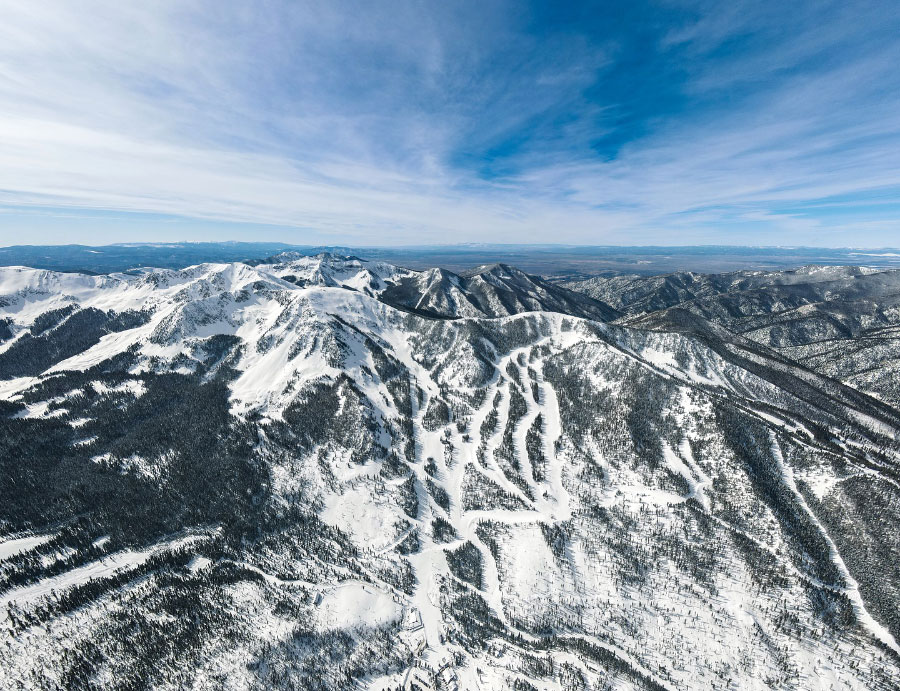
Taos Ski Valley, New Mexico, USA; snowy in the sunshine. Still warm, but cooling, in the Alps, after some snow top-ups. Mixed conditions across America, from not much to some great powder skiing in favoured spots. The Snow Headlines - February 15th - Snowfall in the Alps and Pyrenees; a refresh for most, as much as 50cm. - Montana ski area ends season early as ski areas in Pacific Northwest struggle. - Alpine Ski World Cup back in Andorra after missed French/German weekend. - Some ski areas in Western Canada report around 30cm this week. - Bulgaria stages World Cup GS on Saturday but Sunday's slalom rained off. 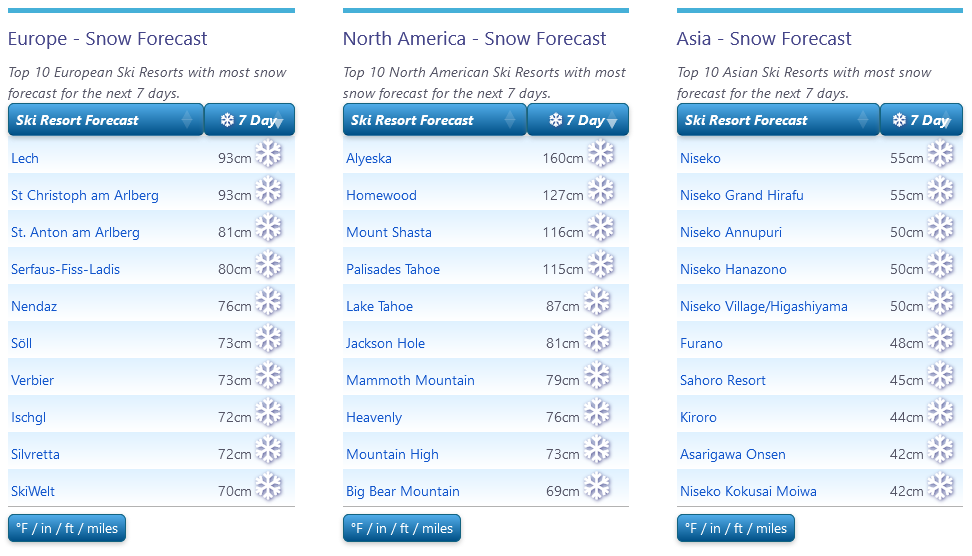
More snow forecast for Europe, USA and Japan
World Overview The forecast heavy snowfall across the Alps didn't really materialise, at least not to the extent hoped, although some areas did at least see some fresh snowfall to refresh their hard-packed slopes. Some resorts in the southwestern Alps have accumulated as much as half a-metre of fresh snow in the last seven days. Most haven't had enough to really reboot freeriding opportunities, the upside of which is that the avalanche danger remains at 1-2 (low) on the scale to 5 almost everywhere. Unfortunately, we're back to warm temperatures in valleys but the weather is more changeable than it was for the previous three weeks and more snow showers are forecast, with cooler weather also imminent. The Pyrenees also saw snow, and conditions are improving in Scotland and remain excellent in Scandinavia, however, Bulgaria was hit by torrential rain at the start of the week, damaging the snowpack. It's been a quieter week for snowfall across North America after the big dumps in California and the Southern Rockies in previous weeks. There has been plenty of sunshine but light snowfalls reported in many areas refreshing cover. Europe Austria Austrian ski areas have seen some good snowfalls this week, with bases on higher slopes at resorts including St Anton, the Kitzsteinhorn Glacier and Solden up 20-30cm at the top of the slopes. There's also been snow down to the valley floor at times, but base depths are still dropping in many areas because although there have been cold spells, we're still seeing mostly warm weather, close to 10C in valleys, and so the thaw continues. Most slopes remain open but snow conditions remain 'sub-optimal' on low runs as soon as the fresh snow gets packed in. More light snow showers are forecast but so is warm sunny weather. Go high for the best conditions! France There have not yet been quite the snowy conditions we were hoping for a week ago in the French Alps, but most areas have seen some snowfall and conditions are greatly refreshed on the hard-packed pistes. There was snow down to the valley floor at the weekend with low-lying resorts like Les Gets posting 10cm of new snow on snow-starved lower runs, although it didn't last long away from prepared runs. Most of the country's ski slopes are open and with the half-term holidays underway the main concern is slope safety due to crowded runs in places. Temperatures remain sub-zero most of the time at altitude and more unsettled weather and snowfall are forecast this weekend. Italy Italian ski areas saw some of the best snowfalls last weekend with resorts in the Dolomites reporting 20-30cm of snowfall and some decent dumps for resorts that had not had so much previously in the Western Alps too, including the Milky Way (Via Lattea) resorts like Sauze d'Oulx and Sestriere. However, it's Cervinia that has posted the biggest base-depth increase, up 20cm at resort level, and 50cm at plateau Rosa, from last week's numbers. Conditions are now similar across the country, back to mostly sunny skies, occasional snow showers and too warm in valleys. Hopefully forecast light to moderate snowfalls over the coming week will materialise as forecast. Switzerland Swiss resorts have had some fresh snow earlier this week before temperatures rose again, particularly in the valleys, meaning some saw snow down low too. Base depths on upper runs climbed 10-20cm on a week ago – whilst valley stats remained unchanged or declined slightly. So essentially the fresh snow has refreshed cover but not made a huge difference down in valleys, while up high everything was open anyway. Verbier and the 4 Valleys continue to post the best numbers, with about 98% of their 410km of slopes open. The forecast is for further light-to-moderate snow showers, but staying quite warm below 1500m altitude Scandinavia Scandinavian ski areas remain in great shape after storm Ingunn blew through over a week ago. More cold and snowy weather has followed in its wake, and with daylight hours rapidly increasing, there are reports of fresh powder and everything open across the region. Snow depths are up to two metres at centres in western Norway with ski areas near coastal Voss posting the biggest numbers. The Folgefonn (Fonna) glacier, which will open in mid-spring, says it has 10 metres of snow lying there, burying the drag lift! Pyrenees Finally, there has been some change to the warm weather that's been dominating the Pyrenees all season. Although it was rather short-lived, with sunshine and warmer temperatures returning after the weekend, Soldeu in Andorra successfully hosted the Women's Alpine World Cup Races on Saturday and Sunday showing fresh snowfall down to the valley floor. Most areas, in the end, received 20-40cm of snowfall before the sunshine returned. It's not made a huge difference to the open terrain, typically 40-70% at most areas in the region, but has been a great slope refresh. Conditions are getting more unsettled again with snow (possibly rain at lower altitudes) forecast. Scotland Following weeks of storms, bringing gales and at times torrential rain, Scottish centres have finally had a fairly calm weather week. Of course, it's half term in Scotland and England so the hope was to have a lot of terrain open but unfortunately that's not the case. There is more than just nursery slope areas open at most and there's been more snowfall, particularly on higher slopes, in recent days. Cairngorm has its nursery area (lift tickets were sold out in advance for the full week) and a return of hike-to terrain above for good skiers. Glenshee has its nursery slopes and limited terrain beyond. The Lecht was just nursery slopes at the time of writing. Nevis Range re-opened on Thursday 15th for the first time in nearly a month. Glencoe has about the most terrain open, more than 10 runs, although some of that terrain is best suited to good skiers. Eastern Europe It was bad news for Bulgarian ski areas at the start of this week with torrential rain first causing the cancellation of the World Cup Slalom racing at Bansko on Sunday and then Pamporovo reporting it was shut down for safety reasons on Monday as the rain there washed away snow cover and the storm even brought lightning strikes damaging lift towers. Further north, rain has also put a dampener on the Biathlon World Championships taking place in the Czech Republic, but there has been snowfall higher up and Slovakia's Jasna has reported fresh snowfall this week. In Bulgaria, the weather has stabilised and returned to sunnier skies but is now a little warm again, unfortunately with little change in the forecast. North America Canada Conditions in Western BC remain challenging with Cypress Mountain and Vancouver Mountain north of Vancouver both still hardly open. Temperatures have dipped a bit and Whistler Blackcomb says it has had over a foot of snow in the last week. It's 75% open with the best conditions up high. Conditions improve the further east you go and into BC then over into Alberta, with resorts around Banff saying they're now 100% open, or thereabouts. It's a similar story in Quebec in the east which has seen much colder weather than the west of the country, down below -10C. USA It has been a quieter week across the US after the big snowfalls in the southwest last week. The snow has kept falling, on and off, with temperatures also mostly remaining below freezing, but it has been a few inches here and there rather than any big dumps. That's the forecast for the coming week too – plenty of sunshine but also light snowfalls delivering an inch or two more snow each time. As slopes are mostly fully open that's fine really, the Pacific Northwest is the region that's still suffering the most from below-average snow cover – Crystal Mountain in Washington State is still only at 60% open for example - but most other regions are fully open, or nearly so. |
|
|
Freeride World Tour - Kicking Horse Golden BC Pro competition confirmed
Second event of the FWT by Peak Performance season to drop this Thursday. · Competition confirmed for this Thursday, February 15 · Venue moved to T1 South · North American leg ready to fire 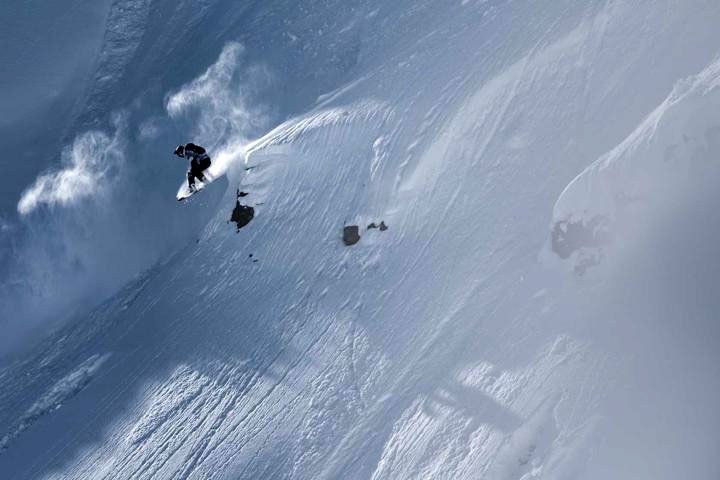
KICKING HORSE, GOLDEN, BC, Canada – February 12, 2024: Stop two of this season's FWT by Peak Performance is poised for action, with FWT organizers giving the green light for competition to take place this Thursday, February 15. Cold temperatures are keeping the snow in prime condition, ahead of blue skies to greet competitors on comp day, providing athletes with promising conditions to deliver an explosive North American leg. This is the second chance for athletes to rack up points before the mid-season cut, but who can carry their form from the Verbier Pro and maintain top positions? Both Núria Castán Barón (Snowboard Women) and Victor de Le Rue (Snowboard Men) will look to strengthen their rankings lead and, with Victor tasting success in Kicking Horse in 2019, he will surely be a firm favorite this year. The Ski Women's category looks stronger than ever, which will be on the mind of current rankings leader Zuzanna Witych as she looks to repeat her Verbier heroics. The Ski Men's category is even harder to pick, with both Kristofer Turdell and Maxime Chabloz standing atop of the podium here in the past, and the current rankings leader, Max Hitzig, is also the reigning champion of this event. 2023 World Champion Justine Dufour-Lapointe (Ski Women) will miss this event for personal reasons, while the rest of the Canadian contingent didn't have the best day out in Verbier. Jackson Bathgate (Ski Men) is at the limit of the Cut, while Marcus Goguen, Weitien Ho (both Ski Men) and Erin Sauve (Snowboard Women) will all need to lift their game to get out of relegation territory. Maybe local charger Stan Rey (Ski Men) will fly the flag for the home country, with this late-addition wildcard looking like a serious podium contender. Thursday's competition will take place on T1 South – which held the event in 2022 – owing to sub-standard conditions on the Ozone Face. The top section of the Ozone is fine, but the middle section has an inconsistent snowpack – from a thick crust to deep, sugary snow over rock – while the bottom is littered with ice cookies the size of watermelons. Hardly ideal for freeride competition. In contrast, T1 South has a consistent snowpack with up to 20 cm of snow covering the old firm crust – including around 5 cm of fresh snow on Tuesday – with cold temperatures ensuring conditions will be suitable for the world's best freeriders. This year, the forerunner will be Jay Rawe, the first sit-skier in FWT history to participate in proceedings. Jay got into sit-skiing after a BASE jumping accident in which he was lucky to survive. Sit-skiing allowed him to follow his passion for the outdoors and charging hard with friends in the mountains. His resume in this discipline is quite impressive, pioneering 540 and 720 spins, as well as featuring in Stomping Grounds by Matchstick Productions and earning an invite to the 2023 Swatch Nines. Live Coverage starts at 10.15 am MST – 6.15 pm CET, with the first rider dropping at 10.30 am MST – 6.30 pm CET. The order will be: · Snowboard Women · Snowboard Men · Ski Women · Ski Men Be sure to watch the event in person if you're in the area, otherwise remember that the competition will be broadcast LIVE at www.freerideworldtour.com, with incredible user-friendly replay options to make sure you don't miss a trick. In the meantime, stay tuned to the FWT social media channels and subscribe to the FWT newsletter to keep pace with the latest news as it drops, including competition and rider updates. 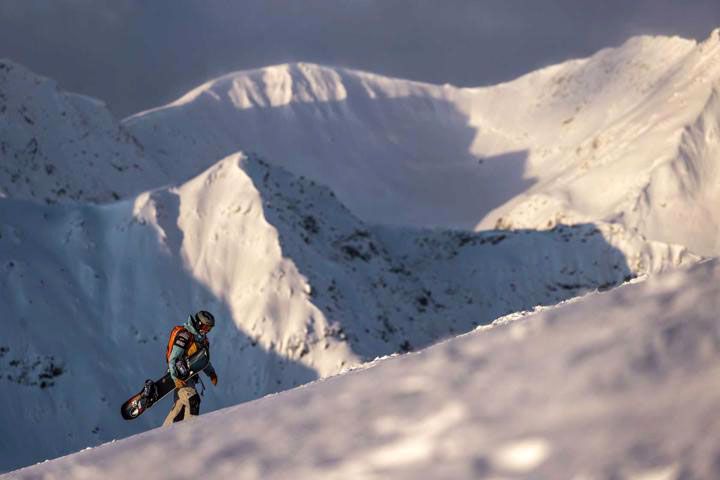
About the FWT FWT Management SA is based in Verbier, Switzerland, and has been organizing premier sports events globally in mountain resorts since 1996. The company founded the Xtreme Verbier, an iconic event in freeride skiing and snowboarding, and turned this single competition into a prestigious series of worldwide events in 2008, the Freeride World Tour (FWT). The company has since grown to include multiple competition series that fall under the FWT brand – including FWT Challenger, FWT Qualifier and FWT Junior – with events across all formats taking place in Europe, North America, South America and Oceania. Since December 2022, FWT is part of the International Ski and Snowboard Federation (FIS). About Peak Performance Born in the Scandinavian mountains out of a love for skiing in remote, untouched terrain, our passion for adventure and nature runs deep. Our purpose is simple: we bring the freeride spirit to the world. As for our products, they all have the same purpose – empower the freedom to be adventurous and follow your own line. Whether it be horizontally or vertically, on skis, by bike, or on foot, they offer a balance of style and performance. Our Scandinavian heritage is ever present and our commitment to doing better things in a better way is our never-ending responsibility. For more information, please visit www.peakperformance.com. 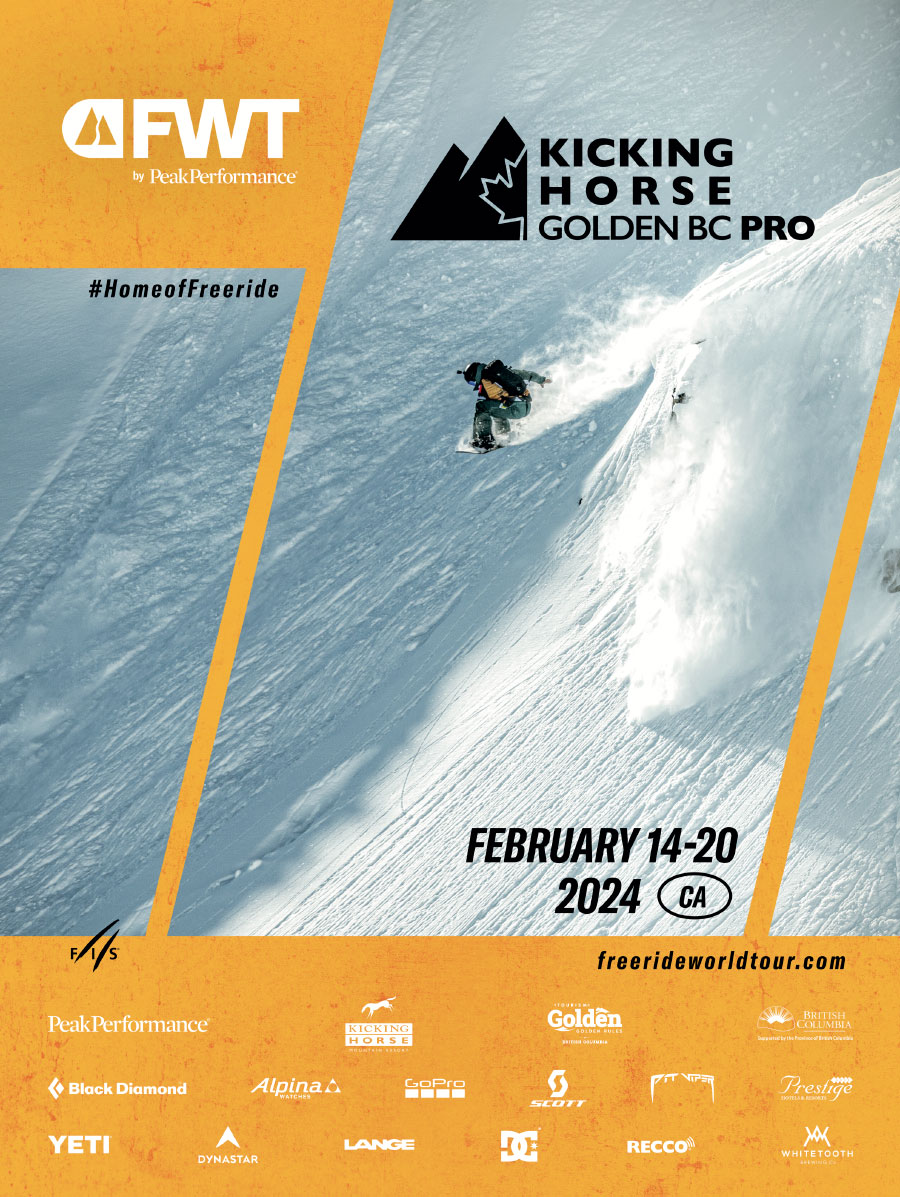
|
|
|
Hi Ash, welcome back (to skiing!),
Whilst you will find plenty of online videos of tots skiing (and even boarding), I'd say they are the exceptions. It depends totally on the child, and their confidence, physical strength and determination (which, as you'll know, all develop at hugely different rates in the early years). At 3, I'd be thinking more in terms of a creche/nursery that has an hour or so (tops) of "playing on skis" each day, rather than lessons. I don't know about Bulgaria, but most French resorts nowadays have small "snow playgrounds" ("Piou Piou"?), usually near a magic carpet, that will have cones and cartoon characters to ski around. If you do go for it, just be prepared :lol: tots get tired/bored/cold/hungry much faster than we do, so any signs of any of those then take a break... |
|
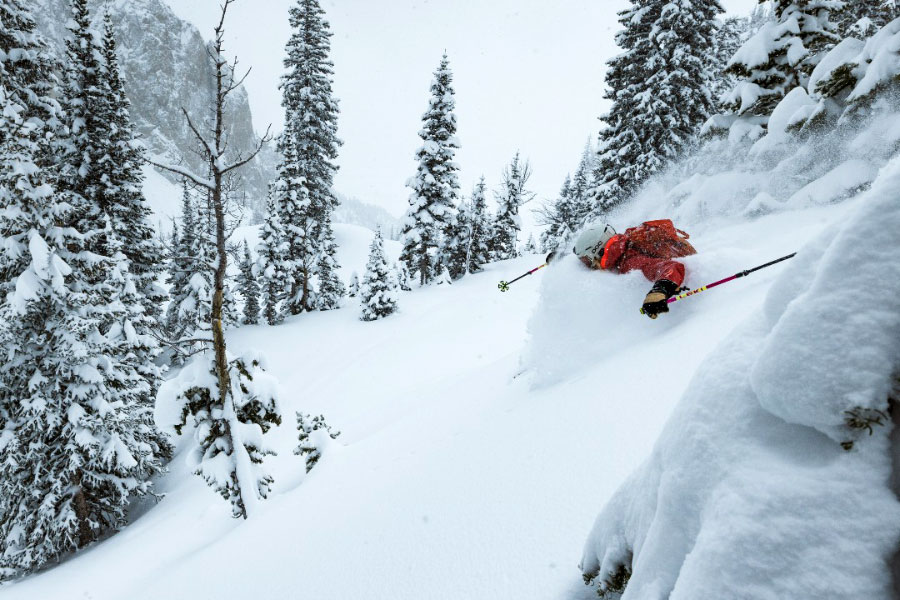
Jackson Hole, Wyoming, 2 feet in 2 days, photo by Stephen Shelesky Snow piles in to the western USA, storms bring snow to Scandinavia and temperatures are dropping (with snow falling) in the Alps. The Snow Headlines - February 8th - Heavy snowfalls hit US West, California buried up to 7 feet deep in powder. - Storm Ingunn leaves snow up to 60cm deep in Norway, Sweden and Finland. - Cooler weather for Western Canada after warm spell causes snow issues. - Temperatures finally dropping in the Alps and Pyrenees after another warm week. - Scottish centres hit by gales, torrential rain and warm weather, again. 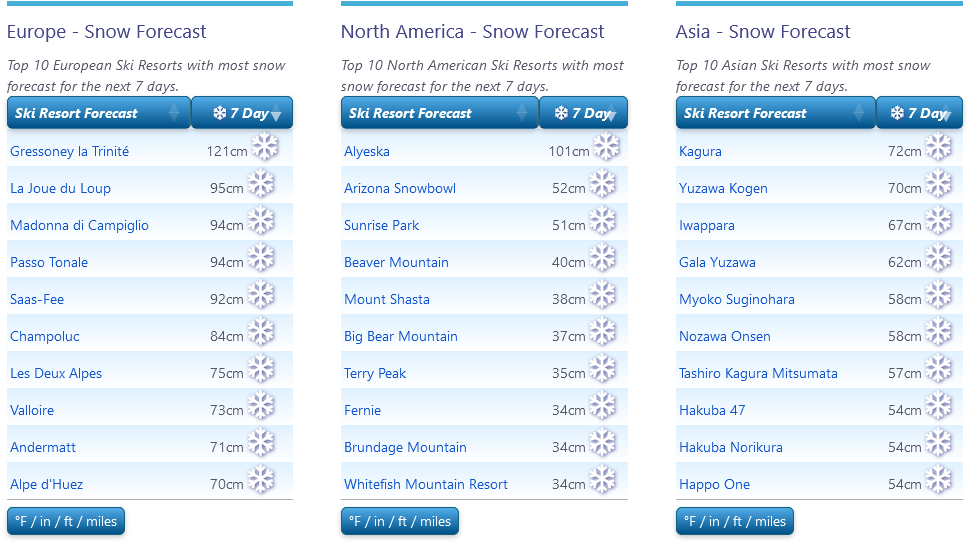
More snow forecast for Europe, USA and Japan
World Overview There's finally a big snowfall to report somewhere – after weeks of not much happening in Europe or North America. The US Pacific coast has been hit by a succession of major snowstorms, which have buried ski centres on the West Coast, particularly in California, in deep powder. The Alps are now seeing warm, dry conditions give way to cooler weather - with snow in the mix. Despite recent warmth, the Alps did get a lot of snow at the start so most areas have good cover and most of their slope depths can survive premature spring thaws for some time. It is now starting to get colder on high slopes in the Alps and snow has arrived. Temperatures are expected to keep dropping and snow falling through the coming week with accumulations up to a metre by this time next week possible in places. Europe Austria Austria has seen a third week of warm temperatures but in terms of thawing from actual ski slopes there's not been a lot and most areas remain 90% or more open. Temperatures have begun dropping, most markedly at altitude and glaciers including the Kitzsteinhorn and Molltal reported fresh snowfall on Wednesday and more since. Temperatures will vary as Foehn winds bring mixed weather this weekend and possibly rain on lower slopes - but by next week we should be closer to freezing to low levels and snowfall should continue, on and off, through the coming week. France French ski areas continue to post the world's deepest snow depths, the only country in fact, where the snow has reached 4 metres up high with Chamonix, Les Arcs and Flaine all claiming that. Despite a third week of warm temperatures to high altitudes there, as across the Alps, snow depth stats are little changed from a week ago, nor the amount of terrain, which remains at 80-100% in big areas. Even the huge Portes du Soliel which has more lower altitude runs around its mostly traditional valley resorts like Les Gets and Morzine is posting that it's over 90% open even as bases drop at 1000m. The French Alps are seeing temperatures dropping and snow arriving too though so hopefully we are back to winter for a while. Italy Italy also had another week of warm weather but they're used to it in the Dolomites and, as previously, it made no real difference to what was open, which remains pretty much everything - albeit with thin bases at lower altitudes. The region looks set to see some of the heaviest snowfall of the coming week and sooner than other areas further north, with 40-80cm accumulations possible by early next week which, if it arrives as forecast, will be about the biggest snowfall of the season so far in the region. Temperatures also dropping back to freezing in valleys at last. Switzerland Swiss centres have 'enjoyed' a second week of mostly sunny skies and warm weather. 'Enjoyed' depends a little on your perspective, with some high-altitude resorts with terrain up above 3,000m like Saas Fee reporting how nice it is to be skiing in the sunshine, while those with lower-level slopes struggling to maintain snow cover are a little less vocal. Regardless, most Swiss ski slopes remain open, thanks to having built good bases before the warm weather arrived. The 4 Valleys with more than 95% of its 410km of slopes open continues to offer the most in the country, although it's nearly 500km skiable from the Swiss side of the Portes du Soleil if you ski over into France for the majority of it. Scandinavia Lots of Scandinavia's ski centres were closed as we published last week's report as Storm Ingunn was blowing through, the most powerful storm to hit the region in three decades. However, in its aftermath, it did leave plenty of snow, so it was quite the powder weekend. Up to 25cm in 24 hours was reported with coastal Voss noting 50cm there through last weekend. The only issue was that it destabilised the snowpack for a few days and the avalanche danger was very high, so skiers and boarders were warned to just stay on the runs deemed safe initially. Pyrenees Another week of warm, sunny weather with the freezing point well above the highest peaks in the Pyrenees most afternoons has further exacerbated the problems facing ski areas in the region as they continue to battle to keep what snowpack there is open. Most of the big areas like Grandvalira in Andorra and Baqueira Beret in Spain have around half their slopes open with old, hard-packed snow. Smaller centres and even some of the bigger resorts like Formigal are battling to open even 20-30% of their terrain. The good news is that it's finally looking colder with snow forecast this weekend. Scotland Sadly, the torrential rain, gale force winds and periods of double-digit plus temperatures have caused more issues for Scotland's five centres which are mostly back down to just the nursery slopes operating thanks to all-weather snowmaking machines following the loss of the thin snowpack. The past few days have been colder and brought some fresh snowfall, improving things a little although not yet making up for lost ground. Eastern Europe Mixed conditions continue in Eastern Europe with lower-lying slopes in the northeast battered by torrential rain earlier this week, although higher runs got some snowfall. The big resorts like Jasna in Slovakia continue to have everything open, but smaller, lower areas are largely closed. In the southeast, Bulgaria, where the world's best male ski racers will be competing at Bansko this weekend in World Cup races, face similar issues. Borovets has shut down about a third of its previously open terrain after weeks of warm weather and also cancelled night skiing. Bansko, on the other hand, has managed to open more runs and now has about 75% of its slopes open, the most of the season so far. North America Canada Conditions in Western Canada continue to be rather hit and miss with warm temperatures and a rising freezing point bringing rain again to lower elevations. Whistler Blackcomb was forced to issue a statement acknowledging the "challenging conditions" and noting some closures due to rain-damaged slopes. Across the sea on Vancouver Island, Mount Washington was forced to announce a temporary complete closure. There have been periods of cold weather and snow, so it's a mixed and dynamic situation. Over in the east it's similar but a little more reliably cold at present and most centres here are open; Tremblant, the largest, fully open. USA It's been mostly good news across the US, but especially in California where torrential rain down at sea level translated to a week of heavy snowfall up high. Mammoth Mountain scored particularly well reporting more than 1.2 metres (four feet) of snow in five days at its base, 2.1m (7 feet) up top, almost as much as they got in all of January and much more than the combined November-December total at the dismal start of the year. Elsewhere there were good snowfalls in the Rockies too, if not so much or for so long but Taos in New Mexico reported over 30 inches (75cm) of fresh snow there and resorts in Colorado and Utah generally picked up about a foot. |
|
|
A return to winter on the cards for Europe, and fresh snow in parts of the USA, are setting things up nicely for February.
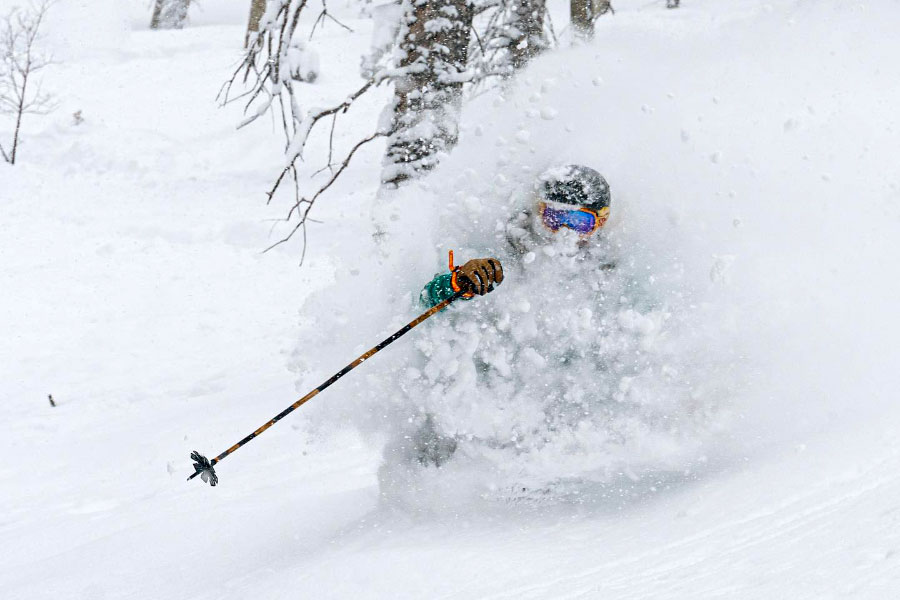
Taos Ski Valley, New Mexico, just got 30 inches of fresh - and seem quite pleased about that! Where to Ski in February 2024 February is here already and anyone skiing at a lower altitude area in the Alps or down in the Pyrenees could be forgiven for thinking we're starting the final month of the season in April, not still in the middle of winter. Warm sunny weather has dominated the latter half of January and is forecast to continue into February, with the freezing point up above the highest peaks in the daytime... but next weekend should see temperatures drop significantly and snow arrive to low levels... keep an eye on our forecasts as the detail will change... In the meantime the positive takeaway is that most resorts got loads of snowfall on higher slopes in the first few months of the season, meaning most runs remain open at all the well-known destination resorts. Overly warm conditions continue to impact the Pyrenees, and it's a similar story in Eastern Europe. Scandinavia has generally the best snow quality and conditions simply because it has stayed colder and Scotland's season starts February in a downturn in its normal rollercoaster of snowy/warm weather extremes. North America had a poor start to the 23-24 season but January saw more consistent cold temperatures and much more snowfall than most centres saw in the last three months of 2023 combined so as a result things are actually looking much better here than they were a month ago - with most slopes now open and more snow forecast to start the month here.
Europe Austria Austria has had a good winter so far. True, there have been warm temperatures at times leaving valley snow wet and periods of heavy rain too, but the country's main ski areas are now long experienced in piling up the snow on lower runs when conditions are right so they survive the bad times. As a result, February dawns with almost every run in the country open, most of the bigger areas running at 85-95% of slopes open with conditions much better up high, for those Austrian areas with plenty of terrain above 1800m. A growing number of areas now have snow lying more than 3 metres (10 feet) deep, about a metre more than we were seeing in early February last year. It's mostly glaciers but also the Arlberg resorts like St Anton. France France is famously busy and expensive in February as crowds arrive for the half-term school holidays which begin on the first full weekend of the month and continue right into March with different regions of France as well as schools across Europe, having different weeks for their half term. This February looks like it'll be a good one though if you can afford to squeeze onto French slopes. Consistent snowfall has left nearly every slope in the country open - albeit with thin cover at low altitude - and France is also posting the deepest bases in the world, with Alpe d'Huez being the first in the world to post a 5-metre base, and several others including Chamonix, Flaine and Les Arcs passing 4 metres. There has been rain at times on low slopes below 1500m so conditions down low have not been so good. Luckily most slopes at the main resorts are above 1800m. Italy Most Italian ski areas are not posting the healthy snow depths we're seeing in the northern Alps and small centres in the Apennines and other southerly mountain areas have had a tough time opening much terrain this winter. Snow depths have grown a little in the Dolomites in January and it seems most ski areas in the region can open pretty much all of their slopes with only a foot of snow lying. So here too the month begins with pretty much everything open. The deepest snow is up in the north west where La Thuile has more than 3m (120 feet) of snow lying. The Milky Way (Via Lattea) region had only comparatively limited terrain (200km of its 400km) open in the first half of January and a thin base. The base there now looks much healthier but it's still only about two-thirds open – although two-thirds is still a lot of runs. Switzerland It's a similar story in Switzerland to the rest of Europe – a very warm end to January and start to February, but with most slopes open at the country's main ski destinations thanks to the fact that they've had plenty of early-season snow and even though it's warmer than it should be above 2000m, it's not so warm that the snow is melting too fast up high. Verbier and the 4 Valleys for example start the month with more than 95% of their slopes reported open, 390km of 410km. Lower down it's not so positive with warmth and rain impacting cover. Here too the hope is that a now overdue return to winter arrives soon in February. Pyrenees Alas if not quite a season to forget, it has been one of the most challenging for ski areas in the Pyrenees to keep operating through, with too warm temperatures and too little snow. There was one chink of light in early January when temperatures dipped, snow fell and more terrain open but the latter half of the month saw a return to +10C in valleys and most areas were limited to just upper mountain runs open. Hopefully, winter will finally arrive properly in the Pyrenees in February – long-term forecasts currently look more optimistic after about the 10th. Scandinavia Scandinavian centres have consistently posted the best snow conditions in Europe through the past three months of the season and February is often a great month to visit as the lows of -30C to -40C and 24-hour polar night of December and January are behind us. The month begins with most of the region's big centres fully open and enjoying rapidly increasing daylight hours. The famous Riksgransen centre up in the Swedish Arctic Circle is due to open for its 2024 season at the end of the month and will have 24-hour daylight by early May! Eastern Europe It's a mixed picture across Eastern Europe but there are similar issues to elsewhere across much of the continent – more southerly and more low-altitude areas battling to get adequate snow cover, higher centres and higher slopes looking pretty good! In terms of open terrain the centres starting February pretty much fully open with a metre or more of snow up top include Bulgaria's Borovets and Slovakia's Jasna. But some well-known destinations like Bansko are still struggling to open lower runs and are closer to 50% open. Scotland Scottish ski centres have had their usual mixed start to the season, although November through January has seen more consistently cold temperatures than in recent years with temperatures remaining in single figures above zero and often sub-zero when other late autumns/winters often see spikes in the teens thawing all the snow. The problem this winter has been not a lot of snowfall to build basses in the first place. But most of the centres maintain nursery slopes with all-weather snowmaking systems and there's been good ski touring in the latter half of January with snow accumulating up high. All five centres were open from mid-January, albeit with limited terrain, so hopefully things will further improve in February. North America Canada Canada hasn't had a particularly good 23-24 season so far with too little snowfall and mild weather for much of November and December. The latter half of January did bring consistently sub-zero temperatures across the country at last (in fact a few days at -40C inland were a bit too cold for operations in parts of Alberta and BC in the middle of last month). So the country's ski slopes start February in the best shape they've been all season to date. Temperatures have been from freezing to -20C the last week of January with snow depths fairly good and almost all areas at least 90% open. USA The US starts February with the best conditions they've seen all season. January transformed the dire start to winter across most of the country with significant snowfalls which continued for much of the month. As a result, we've gone from about 50% of slopes open a month ago to more like 90% now. The biggest transformation has been along the continent's West Coast where resorts like Mammoth were struggling to open much at all, but about two metres of January snowfall has now left them fully open. The Rockies had been in the best shape in November and December and is the place where resorts like Keystone and America's largest area, Park City in Utah, are posting 100% of slopes open for February. Utah also has the deepest snowpack in the country. Much improved on the East Coast as well but still with warm weather blips occurring unfortunately. |
|





